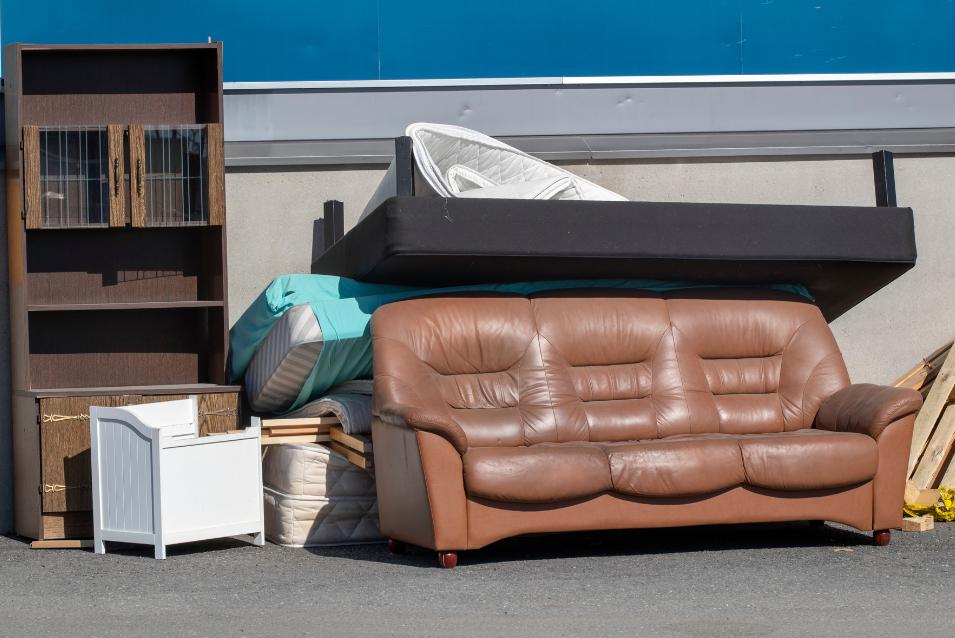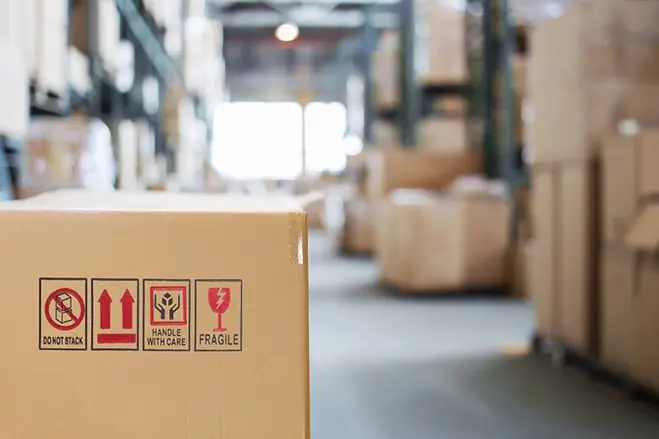
Consequences of Improper Furniture Storage
The fact that you may not currently need or want the furniture you are storing away doesn’t mean that you won’t need it in the future, or that it doesn’t have sentimental value to you, which is why protecting furniture in storage is so important. There is much more to it than wrapping it in a protective layer and tucking it away in a furniture warehouse.
Failing to provide adequate care and attention during the storage process may lead to serious consequences:
1. Scratches and Dents
Moving and stacking furniture without proper protection can lead to friction and abrasion between items, resulting in scratches and dents. These surface imperfections can compromise the aesthetic appeal of your furniture and weaken its structural integrity over time.
2. Moisture and Mold
Long-term furniture storage without proper ventilation can result in moisture accumulating within storage spaces, creating the perfect environment for mold growth, especially when it comes to wooden furniture. Moreover, rapid temperature changes, coupled with poor insulation, can lead to condensation, which can result in mold appearing both on the surface and inside of your furniture.
3. Discoloration and Color Fading
Prolonged exposure to light poses a significant risk to the vibrancy of your furniture’s colors. Whether it’s natural sunlight or artificial lighting, the impact on materials such as fabrics and wooden finishes can be irreversible. Fabrics, especially darker tones, are prone to noticeable fading, while wooden finishes may lose their original shine or darken over time.
4. Pest Infestation and Damage
Termites pose a significant threat to wooden furniture, quietly infiltrating and compromising the structural integrity of your cherished pieces. This can lead to permanent damage that often goes unnoticed until the furniture’s stability is compromised. On the other front, unprotected storage spaces become alluring habitats for rodents and a variety of insects. From mice to beetles, these pests are capable of chewing through upholstery, fabric, and even wood, leaving a destructive trail in their wake.
The risk extends beyond internal damage, as rodents and insects may target external surfaces. Fabrics, upholstery, and the finish on wooden furniture are all vulnerable, and pest infestations can result in unsightly blemishes and compromised aesthetics.
5. Difficulty in Finding and Retrieval
Navigating through a disorganized storage space can turn what should be a straightforward task into a complex and potentially hazardous endeavor. The lack of proper organization and labeling during furniture storing sets the stage for a challenging environment where finding specific items becomes as difficult as searching for a needle in a haystack. This lack of clarity complicates the retrieval process, but it also heightens the likelihood of unintended damage to your stored furniture.

How to Store Furniture
There is much more to furniture warehousing than simply finding temporary space for it; it requires a set of proactive measures to preserve the integrity and longevity of your cherished pieces. Meticulously preparing your furniture for storage is the key to ensuring its safekeeping and pristine condition. Before actually wrapping furniture for storage, you will need to do some detailed preparations for each item.1. Make Sure the Items Are Clean
Dirt, dust, and grime can compromise the aesthetic appeal of your pieces and contribute to serious damage over time. To avoid this, thoroughly dust all surfaces of your furniture using a soft, lint-free cloth. For intricate details or hard-to-reach areas, consider using a small brush to eliminate accumulated dust. Follow up by wiping down surfaces with a mild cleaning solution suitable for the material of each item.
- Upholstered Furniture – Vacuuming will remove any embedded dirt or debris from your upholstered furniture. Check for any stains before storage, as these can become more challenging to treat over time.
- Upholstered Furniture – Vacuuming will remove any embedded dirt or debris from your upholstered furniture. Check for any stains before storage, as these can become more challenging to treat over time.
- Wooden furniture – Wooden furniture requires special attention. Use a gentle wood cleaner to remove any dirt or residue, ensuring that the cleaning product is appropriate for the specific type of wood finish. Apply a protective polish or wax to maintain the luster of the wood.
- Metal and Glass Furniture – For metal or glass elements, use a mild cleaner suitable for these materials. Pay attention to joints and seams, as dirt accumulation in these areas can impact the functionality and aesthetics of the furniture.
- Wooden furniture – Wooden furniture requires special attention. Use a gentle wood cleaner to remove any dirt or residue, ensuring that the cleaning product is appropriate for the specific type of wood finish. Apply a protective polish or wax to maintain the luster of the wood.
After cleaning, make sure you allow all the items to dry completely before storing them away, as this will help prevent the development of mold or mildew during storage.
2. Disassemble the Items
Disassembling your furniture pieces is key for optimizing storage space and keeping your items safe during storage. Before disassembling, make sure you have all the necessary tools. If you’re not sure about what tools you will need, you can check the manufacturer’s guidelines and assembly instructions for your pieces, as they often provide a guide on how to properly disassemble the item, outlining the order of steps and any necessary precautions.
Start by detaching legs from sofas, chairs, and tables to reduce the overall footprint and minimize the risk of damage. For chests and dressers, remove drawers to prevent potential stress on joints and make the items more manageable during transport. When dealing with beds, disassemble them by separating headboards, mattresses, box springs, and footboards.
From the beginning of this process, make sure you have a system for labeling and organizing the hardware. Place screws, bolts, and other small parts in sealed bags or containers, making sure to clearly label them for easy retrieval during reassembly. This will make your life much easier when the time for reassembling comes, as there can be a lot of confusion and frustration if you’re not sure which component belongs to which item.
3. Protect Your Furniture
Once your furniture is disassembled, the next step in the preparation process is to protect each item from potential wear and tear during storage. Using appropriate covers tailored to specific furniture types is crucial. These breathable covers act as barriers against dust, moisture, and scratches. Consider fitted covers for larger items like sofas and mattresses, which will provide comprehensive protection while maintaining breathability. Shrink wrapping furniture is a popular choice, but as it creates a sealed barrier, applying it to damp or even slightly moist furniture will create a breeding ground for mold.
Another layer of defense involves wrapping delicate surfaces with materials like bubble wrap, moving blankets, or foam padding. This extra cushioning shields surfaces such as glass tabletops or polished wood from potential impacts or abrasions. For larger furniture pieces with exposed surfaces, furniture blankets offer excellent protection.
4. Putting Your Items in Storage
Once your furniture is ready for storage, it is a good idea to place pallets or furniture risers beneath items, as it creates an air gap, reducing the risk of condensation and providing additional protection against crawling pests.
For those with a choice, choosing a storage space with climate control is advisable. Maintaining a stable temperature and humidity level helps prevent issues like mold growth, warping, or color fading, ensuring that each piece of furniture emerges from storage in optimal condition.
Thoughtful organization within the storage space, such as arranging larger, sturdier items at the bottom and leaving clear pathways for easy access, further minimizes the risk of damage during storage and facilitates a smooth retrieval process.

Conclusion
Furniture serves as more than mere decor; it becomes an integral part of our homes, reflecting our lifestyles and accumulating memories. The challenges of furniture storage extend beyond merely finding a temporary place for it. Failing to provide proper care may lead to consequences such as scratches, moisture damage, discoloration, pest infestations, and difficulty in retrieval, all of which can compromise the integrity and aesthetics of your items. From the initial cleaning and disassembly to the protective wrapping and strategic placement in storage, each step will contribute to the preservation of your furniture’s quality and beauty.About Us

More than just a white glove delivery company: we specialize in receiving, warehousing, shipping, and national white glove delivery & installation services.
Categories
Related posts
Ready to get started?
Experience new growth opportunities and elevate your business to the next level with our unparalleled white-glove delivery service and extensive coverage. By partnering with us, you can tap into previously undiscovered potential that will drive you closer to your goals.

Latest blog posts
How to Move Artwork for Gallery Exhibitions: A White-Glove Guide
Learn how to move artwork for gallery exhibitions with expert care. Let Elite Anywhere handle your next fine-art move with white-glove service.
Tips To Reduce Long Distance Moving Costs
Explore top-notch OS&E logistics services for luxury hotels & resorts. Find out how specialized providers ensure safe transport, real-time tracking, & accurate installation.
5 Cheapest Ways to Move Furniture To Another State
Explore top-notch OS&E logistics services for luxury hotels & resorts. Find out how specialized providers ensure safe transport, real-time tracking, & accurate installation.

A complete end-to-end logistics company. From receiving to last-mile delivery and everything in between, our staff delivers a true white glove experience with meticulous care and attention to detail. Need something pickup up, crated, and delivered - anywhere in the world? Let's get started!




